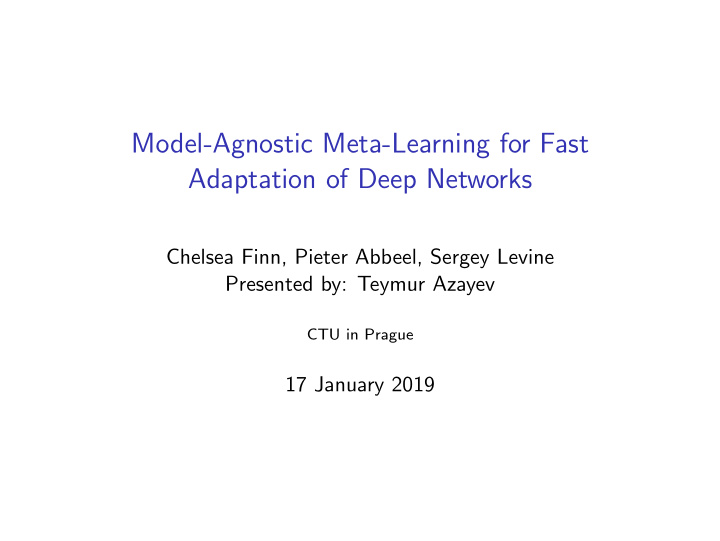



Model-Agnostic Meta-Learning for Fast Adaptation of Deep Networks Chelsea Finn, Pieter Abbeel, Sergey Levine Presented by: Teymur Azayev CTU in Prague 17 January 2019
Deep Learning ◮ Very powerful, expressive differentiable models. ◮ Flexibility is a double edged sword.
How do we reduce the amount of required samples? Use Use Prior knowledge (not in a Bayesian sense). This can be in the form of: ◮ Model constraint ◮ Sampling strategy ◮ Update rule ◮ Loss function ◮ etc...
Meta learning Learning to learn fast. Essentially learning a prior from a distribution of tasks. Several recent successful approaches: ◮ Model based meta-learning [Adam Santoro et al.], [Jx Wang et al.], [Yan Duan et al.] ◮ Metric meta-learning [Gregory Koch, Richard Zemel, and Ruslan Salakhutdinov.], [Oriol Vinyals et al.] ◮ Optimization based meta-learning [Sachin Ravi and Hugo Larochelle], [Marcin Andrychowicz et al.],
MAML Model Agnostic Metal Learning Main idea: Learn a parameter initialization for a distribution of tasks, such that given a new task a small amount of examples (gradient updates) suffice.
Definitions Task T i ∼ p ( T ) is defined as a tuple ( H i , q i , L T i ) consisting of ◮ time horizon H i where for supervised learning H i = 1 ◮ initial state distribution q i ( x 0 ) and state transition distribution q i ( x t +1 | x t ) ◮ Task loss function L T i → R ◮ Task distribution p
Losses ◮ θ ∗ i is the optimal parameter for task T i ′ ◮ θ i is the parameters obtained for task T i after a single update ◮ 2) is the meta objective
Algorithm
Reinforcement learning
Reinforcement learning adaptation
Sin wave regression Tasks: Regressing randomly generated sin waves ◮ amplitudes ranging in [0 . 1 , 5] ◮ phases [0 , 2 π ] ◮ Sampled uniformly in range [ − 5 , 5]
Sin wave regression
Classification tasks Omniglot ◮ 20 instances of 1623 characters from 50 different alphabets ◮ Each instance drawn by a different person ◮ Randomly select 1200 characters for training and the remaining for testing MiniImagenet ◮ 64 training classes, 12 validation classes, and 24 test classes
RL experiment ◮ Rllab benchmark suite, Mujoco simulator ◮ Gradient update are computed using policy gradient algorithms. ◮ Tasks are defined by the agents simply having slightly different goals ◮ Agents are expected to infer new goal from reward after receiving only 1 gradient update.
Conclusion ◮ Simple effective meta learning method ◮ Decent amount of follow up work [ ? ], [ ? ] ◮ Concept extendable to meta learning other parts of the training procedure
Thank you for your attention
References Marcin Andrychowicz et al. Learning to learn by gradient descent by gradient descent. NIPS 2016 Yan Duan et al. RL2: Fast Reinforcement Learning via Slow Reinforcement Learning. 2016 Gregory Koch, Richard Zemel, and Ruslan Salakhutdinov. Siamese Neural Networks for One-shot Image Recognition ICML 2015 Zhenguo Li et al. Meta-SGD: Learning to Learn quickly for few shot learning. 2017 Matthias Plappert et al. Meta-SGD: Parameter Space Noise for Exploration 2017 Sachin Ravi and Hugo Larochelle Meta-SGD:Optimization as a Model for Few-shot Learning ICLR 2017 Adam Santoro et al.
References I
Recommend
More recommend